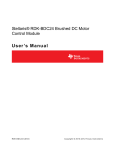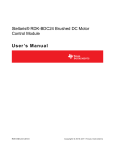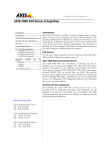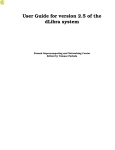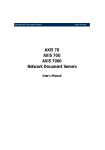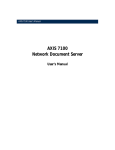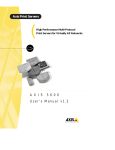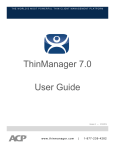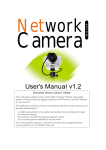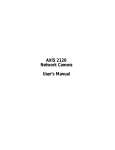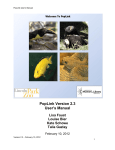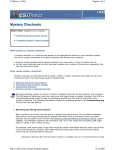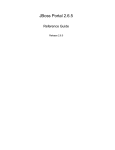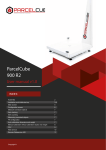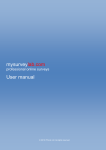Download Meta Information using XML for the AXIS 7000
Transcript
Copyright © 2000 Axis Communications
Meta Information using XML for the AXIS 7000
Introduction
Introduction ......................................... 1
XML....................................................... 1
AXIS 7000 Network Document Server1
Possible applications........................... 1
System Requirements......................... 3
How to do the integration................... 4
1 Installing an FTP Server.................. 4
2 Adding an XML user........................ 4
3 Creating an XML DD file................ 4
Configuring the AXIS 7000................ 5
4 Adding a Destination........................ 5
5 Meta Information configuration........ 6
Example of creating an XML DD file . 7
Creating the XML DD file.................. 7
AXIS MetaData DTD ............................ 9
Pattern ................................................ 13
Description....................................... 13
Internally defined variables............. 14
Default Output format...................... 17
References .......................................... 18
Axis Communications ...................... 19
This document describes how the AXIS 7000 can be integrated with
different kinds of applications using its Meta Information functionality. It
is intended for System Integrators, Developers, and Administrators.
The Meta Information functionality allows the integrator to define a list
of information to be requested (it can be required or optional
information) from the user at the moment of scanning. The user will be
prompted for this information before the document is scanned and sent
over the network.
The Meta information will be sent together with the scanned image in
the Information File or as a separate document. The administrator can
also choose to send information set by the AXIS 7000 itself, e.g. a time
stamp and user identification. This attached Meta information can then
be used by different applications such as accounting software or for
storing in a database server under a unique name.
XML (eXtensible Markup Language) is used as the language to define
the requested information and can also be used as the output format
along with almost any other text based format.
XML
The XML (eXtensible Markup Language) specification defines a
standard way to add Meta Information to documents. Please see the
XML references in the end of this document for further information
about XML.
AXIS 7000 Network Document Server
The AXIS 7000 offers the convenience of allowing end users to
distribute and store documents digitally. The AXIS 7000 offers many
options to do business in a more effective and cost-efficient way. With a
wide variety of formats (TIFF, JPEG/JFIF, PDF, PCL) and transport
methods (SMTP, FTP, LPD, Raw TCP) to choose from, an AXIS 7000
provides increased value to digital copiers and scanners. Included in its
architecture are the embedded Web pages. Administrators can use an
existing Web browser for configuration and management purposes, thus
eliminating the need to load extra software.
Possible applications
http://www.axis.com
Axis Communications (USA)
Tel: (978) 614-2000
Fax: (978) 614-2100
Axis Communications (Europe)
Tel: +46 46 272 18 00
Fax: +46 46 13 61 30
There are numerous examples of how the Meta Information
functionality can be used. Many work or business processes with
documents involved can be improved by adding an AXIS 7000
integrated with an application server. The application server can be
Knowledge Management Systems, Document management Systems,
Imaging Systems, ERP Systems, Databases and Internet Services. Most
application servers connected to a network can be integrated with the
AXIS 7000.
Axis Communications (Japan)
Tel: +81 3 3545 8282
Fax: +81 3 3545 8280
Revision 1.2
Axis Communications Meta Information using XML for the AXIS 7000
01-05-08
Overview
Figure 1 shows the different components involved when using Meta Information and XML together with an
AXIS 7000. A scanner or digital copier is connected to the network using an AXIS 7000. The AXIS 7000 can
then be configured to prompt the user for information at the moment of scanning a document. The
document will be scanned and sent as an image file to a server on the network together with an Information
File. The Information File will include the values entered by the user and can be in a format defined by the
administrator. Almost any format is possible. For instance XML, HTML or a list of values (separated by
commas) would all be possible. XML is used as the language to define the requested information that the
AXIS 7000 downloads from an FTP server on the network.
Database
server
Digital Copier / Scanner
Document Archive
Image +
Information file
Internet /
Intranet
AXIS 7000
FAX Server
Keyboard
Work Flow
FTP Server with
XML DD file
User enter values
<other application>
Figure 1: The components involved in an integration scenario.
2/19
Copyright © 2000 Axis Communications
Axis Communications Meta Information using XML for the AXIS 7000
01-05-08
Figure 2 views the interaction between the XML DD (Data Definition) file, User Input and the resulting
image and Information Files. The XML DD file defines what information that will be requested from the
user and the format of the Information File.
XML DD File
Downloaded from an FTP Server
Image
Document
AXIS 7000
Information File
Application
Internet /
Intranet
Figure 2: The interaction between the XML DD file, User input, image and Information File.
System Requirements
The following main components are needed to build an integrated solution using Meta Information:
• AXIS 7000 with a keyboard connected. Firmware 2.20 or later is required.
• A scanner or digital copier supported by the AXIS 7000. A list of supported devices is available at
http://www.axis.com/techsup/document_servers/axis_7000/index.html.
• An FTP server
• An application server that can handle an image format supported by the AXIS 7000 (PDF, TIFF, JFIF
and PCL) and able to interpret an Information File sent along with it
3/19
Copyright © 2000 Axis Communications
Axis Communications Meta Information using XML for the AXIS 7000
01-05-08
How to do the integration
This section describes the general workflow for integrating the AXIS 7000 with an application. There is an
overview in the flow diagram, followed by a more detailed description of each step in the process.
1
Install an FTP server
2
Add xml user to the FTP server
3
Create an XML DD file and store it in the
XML user home directory
4
Add an application destination to the
Network Document Server
5
Configure the Network Document Server to
retrieve the XML DD file from the FTP server
1 Installing an FTP Server
For the installation of the FTP server, please refer to the FTP server manual. The FTP server will be used for
making the XML DD file available for the AXIS 7000. It can also be used for storing the scanned images and
Information Files if a File Destination is used.
2 Adding an XML user
A new user, xml, will be added to the FTP server user list. The creation of new users and configuration of
their properties differ from each FTP server. Please refer to the FTP server manual for further inf ormation.
The xml user can have any directory as a home directory but it must be appropriate for storing setting files. It
is recommended that you create a new directory for use as the xml user home directory.
3 Creating an XML DD file
The XML DD file specifies what the user will be prompted for and the format and contents of the output
Information File. It can be created and edited in any text editor. The AXIS MetaData DTD defines the syntax
of the XML DD file. The XML DD file will be stored in the home directory of the xml ftp-user, where the
AXIS 7000 will be configured to retrieve it.
The XML DD file will differ depending on which kinds of applications the AXIS 7000 will be integrated
with. There are two issues that need to be resolved prior to writing the file:
• What will the user be prompted for
• Is the user required to enter the value?
• What are the permitted values?
• Is there only a set of valid values?
• The format of the Information File
An example of an XML DD file is shown below:
4/19
Copyright © 2000 Axis Communications
Axis Communications Meta Information using XML for the AXIS 7000
01-05-08
<?xml version='1.0 '?>
<!DOCTYPE MetaDataFile SYSTEM "metadata.dtd">
<MetaDataFile>
<Ask><When><Destination Description="Invoice" /></When>
<MetaData
Required
= "yes"
Id
= "INVOICE_NB"
Prompt
= "Invoice Nb:"
ErrorMessage
= "Wrong Nb!"
DefaultValue
= "00000"
Pattern
= "[0-9]{5}"/>
<MetaData
Required
= "yes"
Id
= "PRIORITY"
Prompt
= "Priority:"
DefaultValue
= "Medium"
Editable
= "no">
<Value>Very High</Value>
<Value>High</Value>
<Value>Low</Value>
<Value>Very Low</Value>
</MetaData>
<Output>
<Format>
InvoiceNb = "$INVOICE_NB$"
Priority
= "$PRIORITY$"
ImageURL
= "$INT_FILE_URL$">
</Format>
</Output>
</Ask>
</MetaDataFile>
The components of the XML DD file are the following:
• Internal variables: In the Information File, it is not only the values entered by the user that can be included
but the internal AXIS 7000 values as well. Examples of variables can be the date, scanner name etc.
• Format section: The format of the Information file is specified here.
• List of values: The Administrator can specify a set of valid values the User can choose from. It is also
possible to specify whether the User is allowed to enter his/her own values
• Pattern: It is possible to determine what the user is permitted to enter by specifying a pattern. Regular
Expressions are used for this.
• Prompts: Each prompt needs a MetaData element entry.
4,5 Configuring the AXIS 7000
The AXIS 7000 can be configured through its internal Web -interface. General knowledge of the product is
prerequisite. Please refer to the AXIS 7000 User’s Manual for information regarding the basic configuration.
4 Adding a Destination
A new destination is added in the Destination section of the Admin part of the Web-interface of the AXIS
7000. Figure 3 shows an example of how it can be configured for a File Destination.
Note: The Destination Name must match a Destination Description in the XML DD file.
5/19
Copyright © 2000 Axis Communications
Axis Communications Meta Information using XML for the AXIS 7000
01-05-08
Figure 3
The value of the parameter Information File Extension will differ depending on which application is used. It
could be html or xml for instance. The default value is txt.
5 Meta Information configuration
The AXIS 7000 has to be configured to retrieve the XML DD file from an FTP server in the network. This
is done on the Meta Information tab in the Edit window accessible from the first Admin page of the
Web-interface. Figure 4 shows an example of how it can be configured. A complete information concerning
the parameters is available online.
6/19
Copyright © 2000 Axis Communications
Axis Communications Meta Information using XML for the AXIS 7000
01-05-08
Figure 4
Example of creating an XML DD file
This section describes an example of how to create an XML DD file for an invoice application. The user will
be prompted for a few specific values when scanning to a specific invoice destination. These values will be
included in an XML formatted Information File sent together with the image file.
Creating the XML DD file
It is good practice to make a table with all prompts and their properties prior to writing the XML DD file. A
simple example for this particular case is shown in Table 1.
Prompt
Invoice Number
Due Date
Issuer
Amount
Importance
Allowed values
00000-99999
A valid date in mm/dd / yyyy formats.
A string
0-9999999999
Enumerated – not editable by the User.
E.g. :Very High, High, Medium, Low, Very Low.
Required
Yes
Yes
Yes
No
No
Table 1
The Administrator has also the possibility to specify a list value the User can choose from.
Apart from specifying the prompts, the format of the Information File must also be decided upon. If there is
no <FORMAT> section of the XML DD file a default format will be used as described in Default Output
format. In this case the Information File will be in XML format and therefore a CDATA section is used to
prevent the XML parser in the AXIS 7000 from parsing that part of the code. Otherwise, normally only a
<FORMAT> section is needed.
7/19
Copyright © 2000 Axis Communications
Axis Communications Meta Information using XML for the AXIS 7000
01-05-08
<?xml version='1.0'?>
<!DOCTYPE MetaDataFile SYSTEM "metadata.dtd">
<MetaDataFile>
<Ask><When><Destination Description="Invoice" /></When>
<MetaData Required
= "yes"
Id
= "INVOICE_NB"
Prompt
= "Invoice Nb:"
ErrorMessage = "Wrong Nb!"
DefaultValue = "00000"
Pattern
= "[0-9]{5}"
/>
<MetaData Required
= "yes"
Id
= "DUE_DATE"
Prompt
= "Due Date:"
ErrorMessage = "Wrong Date!"
DefaultValue = "01/01/2000"
Pattern
= "[0-9]{2}/[0 -9]{2}/[0 -9]{4}"
/>
<MetaData Required
= "yes"
Id
= "ISSUER"
Prompt
= "Issuer:"
ErrorMessage = "Enter the name."
Pattern
= ".+"
/>
<MetaData Required
= "no"
Id
= "AMOUNT"
Prompt
= "Amount:"
ErrorMessage = "Enter the amount."
Pattern
= "[0-9]{,10}"
/>
<MetaData Required
= "no"
Id
= "IMPORTANCE"
Prompt
= "Importance:"
DefaultValue = "Medium"
Editable
= "no">
<Value>Very High</Value>
<Value>High</Value>
<Value>Low</Value>
<Value>Very Low</Value>
</MetaData>
<Output>
<Format>
<![CDATA[<?xml version="1.0"?>
<!DOCTYPE Invoice SYSTEM "invoice.dtd">
<Invoice InvoiceNb = "$INVOICE_NB$"
DueDate
= "$DUE_DATE$"
Issuer
= "$ISSUER$"
Amount
= "$AMOUNT$"
ImageURL = "$INT_FILE_URL$">
</Invoice>
]]>
</Format>
</Output>
</Ask>
</MetaDataFile>
For further information regarding writing an XML DD file please refer to the AXIS 7000 documentation
and the sections AXIS MetaData DTD, Pattern syntax and Internal variables.
8/19
Copyright © 2000 Axis Communications
Axis Communications Meta Information using XML for the AXIS 7000
01-05-08
AXIS MetaData DTD
The DTD (Document Type Definition) is a specific definition of the rules and syntax that the DD
(Document Description) file must follow. It contains the definition of the element hierarchy and relation
between these elements in the hierarchy. When your XML DD file is processed, it is compared to its
associated DTD to be sure that it is structured correctly and that all tags are correctly used. The AXIS
MetaData DTD file defines the syntax of the XML DD file used for specifying the prompts that will be
shown on the AXIS 7000 control panel display as well as the format of the Information File with the entered
values. As from the 2.23 release of the firmware, you have the possibility to download from the AXIS 7000
into your favorite validating editor, the DTD used internally. This mechanism allow you to create, validate
and upload the AXIS 7000 XML DD file in a straight forward process. See the User Manual for more
information.
<?xml version="1.0" ?>
<!-=============================================================== ======================
FILE:
metadata.dtd
ROOT:
MetaDataFile
DESCRIPTION: This file contains the DTD for the Meta Data functionality. This
functionality allows the Administrator to define custom information that will
be required from the User at the moment of scanning. This custom information
can either be related to a particular destination (for instance an Invoice
number when an invoice destination is selected) or it can be requested
regardless of the destination.
====================================================================================== ->
<!-=====================================================================================
ENTITY:
MD_DTD_VERSION
DESCRIPTION: This entity contains the version number of this DTD.
================================================================ -->
<!ENTITY MD_DTD_VERSION "1.00">
<!-=====================================================================================
ENTITY:
MD_DOMAIN
DESCRIPTION: This entity contains the domain of this DTD.
====================================================================================== ->
<!ENTITY MD_DOMAIN "XML meta data">
<!-=====================================================================================
ELEMENT:
MetaDataFile
PARENT:
None
CHILD:
AlwaysAsk (optional)
Ask (zero or more)
ATTRIBUTES: None
DESCRIPTION: This element is the root element. It allows the Administrator to define meta
data that will always be requested (gathered in the "AlwaysAsk" section)
regardless of the destination, and meta data that will be requested only when
a particular destination is selected (gathered in the "Ask" section).
====================================================================================== ->
<!ELEMENT MetaDataFile (AlwaysAsk?, Ask*)>
<!ATTLIST MetaDataFile
Version CDATA #FIXED "&MD_DTD_VERSION;"
Domain CDATA #FIXED "&MD_DOMAIN;">
<!-=====================================================================================
PARENT:
MetaDataFile
9/19
Copyright © 2000 Axis Communications
Axis Communications Meta Information using XML for the AXIS 7000
CHILD:
01-05-08
MetaData (one or more)
Output (optional)
ATTRIBUTES: None
DESCRIPTION: This element gathers the meta data that is requested from the user
regardless of the destination. This does not imply that the different meta
data is required but just that it is not destination dependent as the meta
data gathered in the "Ask" section is. For instance the Administrator can
always ask the User to identify himself. This is not destination dependent.
====================================================================================== ->
<!ELEMENT AlwaysAsk (MetaData+, Output?)>
<!-=====================================================================================
ELEMENT:
Ask
PARENT:
MetaDataFile
CHILD:
When (one)
MetaData (one or more)
Output (optional)
ATTRIBUTES: None
DESCRIPTION: This element gathers the different meta data that is Destination dependent.
The Administrator is able to specify the meta data which is to be requested
from the User on selecting a specific destination (gathered in the "When"
element). This section also allows the Administrator to define the specific
format of the output for this set of MetaData. For instance, the
Administrator can ask for an invoice number when the User selects the invoice
destination. He can also define a particular output format that can easily be
processed (by a database for instance).
====================================================================================== ->
<!ELEMENT Ask (When, MetaData+, Output?)>
<!-=====================================================================================
ELEMENT:
Meta Data
PARENT:
AlwaysAsk
Ask
CHILD:
Value (zero or more)
ATTRIBUTES: Required:
This attribute is an enumerated value that defines if the User must enter
the MetaData (="yes") or if it can be skipped (="no") or if it is hidden to
the User (="hidden"). MetaData with the "Required" attribute defined as
"yes", is mandatory and must be entered before the User can proceed with
the scanning. MetaData with the "Required" attribute defined as "hidden",
is useful when the administrator wants to define a default value that will
help in processing the information entered by the User.
Id:
This attribute indicates the system and name the MetaData is known by. This
identifier must be unique among all the MetaData elements.
Prompt:
This attribute contains the string that will be displayed on the LCD
display when requesting this particular MetaData from the User. If the
Administrator does not specify the text the User will be prompted with the
"Id" attribute.
Label:
This attribute contains the output string when the Administrator has not
defined an output format. If no labels are defined, the "Id" attribute will
be used instead.
ErrorMessage:
This attribute contains the string that will be displayed when the value
entered by the User does not match the "Pattern" attribute. If the
Administrator does not specify this attribute, the default string
"Incorrect value!" will be displayed instead.
DefaultValue:
10/19
Copyright © 2000 Axis Communications
Axis Communications Meta Information using XML for the AXIS 7000
01-05-08
This attribute contains the output string for when the MetaData is not
required and not entered by the User (attribute "Required" equal "no") or
hidden (attribute "Required" equal "hidden"). The default value for this
attribute is the empty string.
Pattern:
This attribute contains the regular expressions that describe the expected
format in the value entered by the User. For more details on the Regular
Expression syntax see the User’s Manual. The default value for this
attribute is the match -everything pattern (".*").
Editable:
This attribute is an enumerated value that defines if the User is allowed
to enter a value different from the one purposed in the list of value
defined for this Meta Data. The User will be allowed if the attribute is
set to "yes" and will not be if the attribute is et to "no"
DESCRIPTION: This element contains the information specific to the meta data itself. See
the attribute descriptions for more details.
====================================================================================== ->
<!ELEMENT MetaData (#PCDATA | Value)*>
<!ATTLIST MetaData
Required
(yes | no | hidden) "no"
Id
ID
#REQUIRED
Prompt
CDATA #IMPLIED
Label
CDATA #IMPLIED
ErrorMessage CDATA #IMPLIED
DefaultValue CDATA #IMPLIED
Pattern
CDATA #IMPLIED
Editable
(yes | no) "yes">
<!-=====================================================================================
ELEMENT:
Value
PARENT:
MetaData
CHILD:
None
ATTRIBUTES: None
DESCRIPTION: This element contains a specific value for a Meta Data. This allow the User
to choose the value of a certain Meta Data among several value.
====================================================================================== ->
<!ELEMENT Value (#PCDATA)>
<!-=====================================================================================
ELEMENT:
When
PARENT:
Ask
CHILD:
Destination (one or more)
ATTRIBUTES: None
DESCRIPTION: This element contains a list of the different destinations that trigger the
request of the dependent MetaData elements from the User. When one or more of
the specified destinations is selected by the User, the following MetaData
will be requested
====================================================================================== ->
<!ELEMENT When (Destination+)>
<!-=====================================================================================
ELEMENT:
Destination
PARENT:
When
To
CHILD:
None
ATTRIBUTES: Description:
This is the Id of the Destination. One restriction is that the
destination's
description
attribute
must
be
a
valid
destination
11/19
Copyright © 2000 Axis Communications
Axis Communications Meta Information using XML for the AXIS 7000
01-05-08
description. This means that the Administrator cannot define a new
destination here.
DESCRIPTION: This element contains the description of the defined destination
====================================================================================== ->
<!ELEMENT Destination (#PCDATA)>
<!ATTLIST Destination
Description
CDATA
#REQUIRED>
<!-=====================================================================================
ELEMENT:
Output
PARENT:
AlwaysAsk
Ask
CHILD:
To (optional)
Format (optional)
ATTRIBUTES: FileName
This attribute indicate to the AXIS 7000 which template it should use in
order to determine the remote file name. This template can contain
references to Meta Data’s Id, in order to create a file name that is
created with the values entered by the User. This attribute overrides the
value set for the Destination.
DESCRIPTION: This element contains the specific information for when the Administrator
wants to specify a format different from the traditional one. The
Administrator can also specify a destination for the output file.
=========================================================== =========================== ->
<!ELEMENT Output (To | Format | (To, Format))>
<!-=====================================================================================
ELEMENT:
To
PARENT:
Output
CHILD:
Destination
ATTRIBUTES: None
DESCRIPTION: This element contains the particular destination to which the output file
should be sent.
====================================================================================== ->
<!ELEMENT To (Destination))>
<!-=====================================================================================
ELEMENT:
Format
PARENT:
Output
CHILD:
None
ATTRIBUTES: None
DESCRIPTION: This element contains the custom declaration that defines the output format
defined by the Administrator for this specific destination.
====================================================================================== ->
<!ELEMENT Format (#PCDATA)>
12/19
Copyright © 2000 Axis Communications
Axis Communications Meta Information using XML for the AXIS 7000
01-05-08
Pattern
Each MetaData element is defined in the XML DD file. In this file a pattern is specified. The pattern is a set
of regular expressions used to check the lexical correctness of the value. The format is enclosed into a string
delimited by the ’"’ (quote) character, new lines are not accepted in the regular expression. Infix notation is a
structure notation where the operator is located between the operands, e.g. (A+B). In postfix notation the
operator follows the operands, e.g. (A,B)+.
Character
.
+
*
?
[..]
R{1,5}
R{1}
R{,2}
R{2,}
^
$
"a|b"
|
\
Description
Matches any character except new line.
(postfix) matches the previous expression one or several times
(postfix) matches the previous expression zero, one or several times
(postfix) matches the previous expression once or not at all
Character set; ranges are denoted with -, as in [a-z]; an initial ^, as in [^0-9],
complements the set
r could be repeated between 1 and 5 times
r must be repeated exactly once.
r could be repeated twice (i.e. 0, 1 or 2 times).
r must be repeated at least twice.
Matches at beginning of line
Matches at end of line
"a" or "b"
(infix) Alternative between two expressions
\ quotes special characters.
The following table shows a few examples of regular expressions
Example
Description
“[0-9]{2}/[0-9]{2}/[0-9]{4}”
Date
DD/MM/YYYY
E-mail address
[email protected]
[email protected]
Telephone number
"(123)1231234"
"(123)1231234"
"123 1234"
"1231234"
Name
"John Doe"
"John"
ZIP code
"12345"
"12 345"
Time
"1:05:59 AM"
"[a-zA-Z]+)|([a -zA-Z]+.[a-zA-Z]+)@[a-zA-Z]+.[az]{2,3}"
"(\([0-9]{3}\))?[0-9]{3}[ ]{,1}[0-9]{4}"
"[a-zA-Z ]+"
"[0-9]{2} ?[0-9]{3}"
"(1|2|3|4|5|6|7|8|9|10|11|12):[0-9]{,2}(:[0-9]{0,2})
?(AM|am|Am|PM|pm|Pm)"
"(^((http://)|(ftp://)|(https://)|(gopher://)))?([azA-Z0-9]+.)*[a -zA-Z0-9]+(/([a-zA-Z0-9]|-|.)+)*"
13/19
Copyright © 2000 Axis Communications
URL
"http://www.axis.com/prod/index.
html"
"ftp://ftp.axis.com/pub/"
"www.axis.com"
Axis Communications Meta Information using XML for the AXIS 7000
01-05-08
Internally defined variables
There are several internal variables defined by the AXIS 7000 that can be output in the Information File. They
can be used as any other variable in the XML DD file. Example:
…
<Format>
The image is located at $INT_FILE_URL$
The time at the moment of scanning was $INT_TIME$
</Format>
…
Variable name
INT_BITS_PER_PIXEL
INT_CONTRAST
INT_DATA_TYPE
INT_DATE
INT_DESTINATION
INT_DOUBLE_SIDED
INT_FILE_NAME
INT_FILE_SIZE
INT_FILE_URL
INT_FORMAT
INT_HEIGHT
Description
This reference name will be used to output the number of
bits per pixel of the image file.
Example : 1
This reference name will be used to output the contrast of
the image file.
Example : 50
This reference name will be used to output the data type
of the image file.
Example : Black & white
This reference name will be used to output the date of the
image file.
Example : 2000-05-04
This reference name will be used to output the destination
description that originated the Information File.
Example : Invoice
This reference name will be used to output the orientation
of the image file.
Example : Off
This reference name will be used to output only the file
name of the image file.
Example : image.tif
This reference name will be used to output the size of the
image file.
Example : 54490
This reference name will be used to output the file URL of
the image file. In the case of a file on an FTP server, this
will correspond to the complete URL of the file. In the
case of an Email to a pre-set destination it will correspond
to the URL specified on the web interface.
Example : ftp://server/image.tif
This reference name will be used to output the format of
the image file.
Example : CCITT G.4
This reference name will be used to output the height of
the image file.
Example : 3300
14/19
Copyright © 2000 Axis Communications
Axis Communications Meta Information using XML for the AXIS 7000
INT_HOST_ADDRESS
INT_HOST_NAME
INT_INTENSITY
INT_MAC_ADDRESS
INT_NUMBER_OF_PAGES
INT_PAPER_ORIENTATION
INT_PAPER_SIZE
INT_PROFILE
INT_SCANNER
INT_SUBJECT
INT_TIME
INT_USER_ID
INT_USER_MAIL
INT_WIDTH
INT_X_RESOLUTION
INT_Y_RESOLUTION
INT_LAST_RESET_DATE
01-05-08
This reference name will be used to output the IP address
of the AXIS 7000 that produced the image file.
Example: 10.13.3.231
This reference name will be used to output the host name
of the AXIS 7000 that produced the image file.
Example : computer.company.com
This reference name will be used to output the intensity of
the image file.
Example : 50
The MAC-address of the AXIS 7000.
Example: 00:40:8c:18:04:e2
This reference name will be used to output the number of
page of the image file.
Example : 2
This reference name will be used to output the paper
orientation of the image file.
Example : Portrait
This reference name will be used to output the paper size
used for the scanning.
Example : Letter
This reference name will be used to output the profile
used for the scanning.
Example : Text
This reference name will be used to output the descriptive
name of the scanner that produced the image file.
Example : RICOH IS450
This reference name will be used to output the selected
subject.
Example : Here comes the document
This reference name will be used to output the time of the
image file.
Example : 14:25:25
This reference name will be used to output the description
of the user.
Example : John Smith
This reference name will be used to output the email
address of the user.
Example : [email protected]
This reference name will be used to output the width of
the image file.
Example : 2528
This reference name will be used to output the horizontal
resolution of the image file.
Example : 300
This reference name will be used to output the vertical
resolution of the image file.
Example : 300
This reference name will be used to output the date of the
last time the counter has been reset.
Example : “Thu Mar 22 15:20:54 2001”
15/19
Copyright © 2000 Axis Communications
Axis Communications Meta Information using XML for the AXIS 7000
01-05-08
INT_COUNTER_LAST_RESET This reference name will be used to output the number of
page scanned since the last reset of the counter.
Example : 102
INT_COUNTER_TOTAL
This reference name will be used to output the number of
page scanned since the beginning of times
Example : 9261
16/19
Copyright © 2000 Axis Communications
Axis Communications Meta Information using XML for the AXIS 7000
01-05-08
Default Output format
The Information File includes all values that the user entered at the moment of scanning to a destination that
specifies Meta Information. It is possible to either use a default format of the Information File or to specify
an own. If there is no <FORMAT> section in the XML DD file the default format will be used. It is
formatted like <ID> = <VALUE>. An example of an Information File is shown below. Except for the
Meta Information it also includes the normal image information. It is possible to only get the Meta
Information by setting the Include Image Information parameter for the destination to None.
; AXIS 7000 Parameter List, V2.20 June 12 2000
[General]
File name
= image.tif
File size
= 100164
Date
= Thu Jun 12 12:55:06 2000
Host address
= 10.13.3.231
Scanner
= RICOH IS450
Destination
= Invoice
Profile
= Text
Paper size
= Letter
Number of pages
= 1
[Image Information]
Width
Height
X Resolution (DPI)
Y Resolution (DPI)
Bits per pixel
Data type
Paper orientation
Format
Double-sided
Intensity
Contrast
=
=
=
=
=
=
=
=
=
=
=
2528
3300
300
300
1
Black & white
Portrait
CCITT G.4
Off
50
50
[Metadata]
INVOICE
DATE
ISSUER
AMOUNT
=
=
=
=
12456
01/25/2000
ACME Corp
5020
17/19
Copyright © 2000 Axis Communications
Axis Communications Meta Information using XML for the AXIS 7000
01-05-08
References
There are several different resources on the Internet with information regarding XML. A few of them are
listed below for reference.
www.w3.org/XML
www.xml.org
www.xml.com
18/19
Copyright © 2000 Axis Communications
Axis Communications Meta Information using XML for the AXIS 7000
01-05-08
Axis Communications
Axis is a world leader in the rapidly growing network-attached peripherals industry. Headquartered in
Sweden, Axis designs and manufactures network-attached print servers, network document servers,
CD/DVD servers, camera servers and storage devices based on its ThinServerTM Technology.
All Axis products leverage Axis’ own ThinServer Technology, which allows any peripheral device to be directly attached to the
network without a file server or PC. These devices are displayed on any desktop without changing client software and can be
accessed and used by multiple clients using virtually any desktop and network operating system. The core of ThinServer
Technology is the embedded software consisting of self-contained, "thin" versions of popular operating systems, a Web
server for consistent, network-wide management, and an optimized 32-bit RISC chip complete with device I/O and
network controllers for high-speed data transport.
19/19
Copyright © 2000 Axis Communications



















